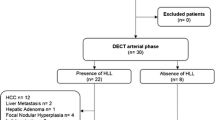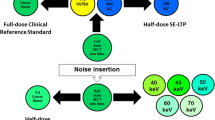Abstract
Purpose
To compare virtual non-enhanced liver CT (VNCT) from dual-energy CT (DECT) with true non-enhanced liver CT (TNCT) in patients.
Methods
A total of 102 patients underwent multi-phase abdominal CT. Liver arterial VNCT (VNCTA) and portovenous VNCT (VNCTV) images were derived from the arterial and portovenous DECT data. The mean CT number, signal to noise ratio (SNR), image quality, contrast to noise (CNR) of liver lesions, lesion detectability and radiation dose were compared.
Results
There was no difference in mean CT numbers of all organs (all P > 0.05). SNR on VNCT images was higher than that of TNCT (all P < 0.001). Image quality of VNCT was diagnostic but lower than that of TNCT (P < 0.001). VNCTA images were superior to VNCTV (P < 0.001). VNCTA and VNCTV detected 78 (91%) and 70 (81%) of 86 hepatic focal lesions visualised on TNCT. There was no difference in the size, attenuation and CNR of focal hepatic lesions (all P > 0.05), but SNR of the lesions on VNCT was higher than that on TNCT (P < 0.001). Radiation dose of biphase DECT was lower than that of routine triphase CT (P < 0.001).
Conclusion
VNCTA may potentially replace TNCT as part of a multi-phase liver imaging protocol with consequent saving in radiation dose.




Similar content being viewed by others
Abbreviations
- VNCT:
-
virtual non-enhanced CT
- VNCTA :
-
virtual non-enhanced CT images derived from the arterial phase dual-energy CT data
- VNCTV :
-
virtual non-enhanced CT images derived from the portovenous phase dual-energy CT data
- TNCT:
-
true non-enhanced liver CT
References
Johnson TR, Krauss B, Sedlmair M, Grasruck M, Bruder H, Morhard D, Fink C, Weckbach S, Lenhard M, Schmidt B, Flohr T, Reiser MF, Becker CR (2007) Material differentiation by dual energy CT: initial experience. Eur Radiol 17:1510–1517
Zhang LJ, Zhao YE, Wu SY, Yeh BM, Zhou CS, Hu XB, Hu QJ, Lu GM (2009) Pulmonary embolism detection with dual-energy CT: experimental study of dual-source CT in rabbits. Radiology 252:61–70
Zhang LJ, Chai X, Wu SY, Zhao YE, Hu XB, Hu YX, Xue YB, Yang GF, Zhu H, Lu GM (2009) Detection of pulmonary embolism by dual energy CT: correlation with perfusion scintigraphy and histopathological findings in rabbits. Eur Radiol 19:2844–2854
Ruzsics B, Lee H, Zwerner PL, Gebregziabher M, Costello P, Schoepf UJ (2008) Dual-energy CT of the heart for diagnosing coronary artery stenosis and myocardial ischemia-initial experience. Eur Radiol 18:2414–2424
Watanabe Y, Uotani K, Nakazawa T, Higashi M, Yamada N, Hori Y, Kanzaki S, Fukuda T, Itoh T, Naito H (2009) Dual-energy direct bone removal CT angiography for evaluation of intracranial aneurysm or stenosis: comparison with conventional digital subtraction angiography. Eur Radiol 19:1019–1024
Boll DT, Patil NA, Paulson EK, Merkle EM, Simmons WN, Pierre SA, Preminger GM (2009) Renal stone assessment with dual-energy multidetector CT and advanced postprocessing techniques: improved characterization of renal stone composition-pilot study. Radiology 250:813–820
Marin D, Nelson RC, Samei E, Paulson EK, Ho LM, Boll DT, DeLong DM, Yoshizumi TT, Schindera ST (2009) Hypervascular liver tumors: low tube voltage, high tube current multidetector CT during late hepatic arterial phase for detection-initial clinical experience. Radiology 251:771–779
Graser A, Johnson TR, Hecht EM, Becker CR, Leidecker C, Staehler M, Stief CG, Hildebrandt H, Godoy MC, Finn ME, Stepansky F, Reiser MF, Macari M (2009) Dual-energy CT in patients suspected of having renal masses: can virtual nonenhanced images replace true nonenhanced images? Radiology 252:433–440
Stolzmann P, Frauenfelder T, Pfammatter T, Peter N, Scheffel H, Lachat M, Schmidt B, Marincek B, Alkadhi H, Schertler T (2008) Endoleaks after endovascular abdominal aortic aneurysm repair: detection with dual-energy dual-source CT. Radiology 249:682–691
Chandarana H, Godoy MC, Vlahos I, Graser A, Babb J, Leidecker C, Macari M (2008) Abdominal aorta: evaluation with dual-source dual-energy multidetector CT after endovascular repair of aneurysms-initial observations. Radiology 249:692–700
Ferda J, Novák M, Mírka H, Baxa J, Ferdová E, Bednářová A, Flohr T, Schmidt B, Klotz E, Kreuzberg B (2009) The assessment of intracranial bleeding with virtual unenhanced imaging by means of dual-energy CT angiography. Eur Radiol 19:2518–2522
Behrendt FF, Schmidt B, Plumhans C, Keil S, Woodruff SG, Ackermann D, Mühlenbruch G, Flohr T, Günther RW, Mahnken AH (2009) Image fusion in dual energy computed tomography: effect on contrast enhancement, signal-to-noise ratio and image quality in computed tomography angiography. Invest Radiol 44:1–6
Fletcher JG, Takahashi N, Hartman R, Guimaraes L, Huprich JE, Hough DM, Yu L, McCollough CH (2009) Dual-energy and dual-source CT: is there a role in the abdomen and pelvis? Radiol Clin North Am 47:41–57
Yeh BM, Shepherd JA, Wang ZJ, Teh HS, Hartman RP, Prevrhal S (2009) Dual-energy and low-kVp CT in the abdomen. AJR Am J Roentgenol 193:47–54
Brenner DJ, Elliston CD (2004) Estimated radiation risks potentially associated with full-body CT screening. Radiology 232:735–738
Graser A, Johnson TR, Chandarana H, Macari M (2008) Dual energy CT: preliminary observations and potential clinical applications in the abdomen. Eur Radiol 19:13–23
Ma X, Samir AE, Holalkere NS, Sahani DV (2008) Optimal arterial phase imaging for detection of hypervascular hepatocellular carcinoma determined by continuous image capture on 16-MDCT. AJR Am J Roentgenol 191:772–777
Author information
Authors and Affiliations
Corresponding author
Rights and permissions
About this article
Cite this article
Zhang, LJ., Peng, J., Wu, SY. et al. Liver virtual non-enhanced CT with dual-source, dual-energy CT: a preliminary study. Eur Radiol 20, 2257–2264 (2010). https://doi.org/10.1007/s00330-010-1778-7
Received:
Revised:
Accepted:
Published:
Issue Date:
DOI: https://doi.org/10.1007/s00330-010-1778-7




